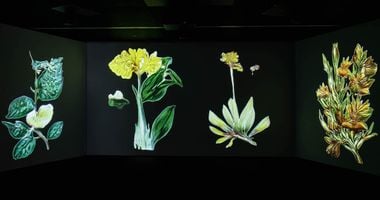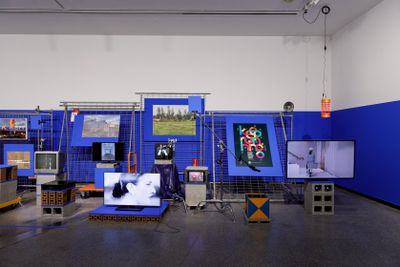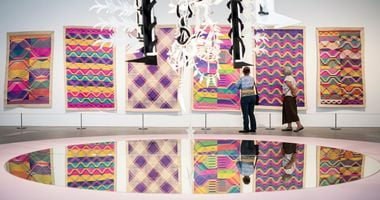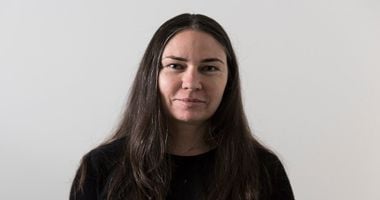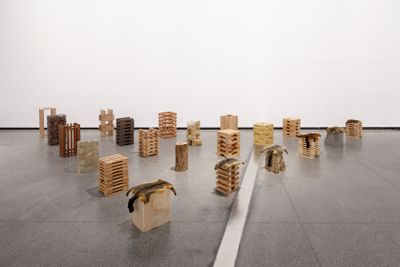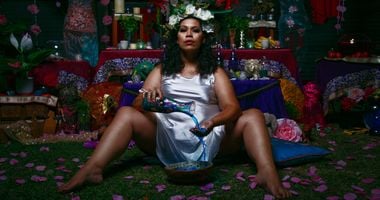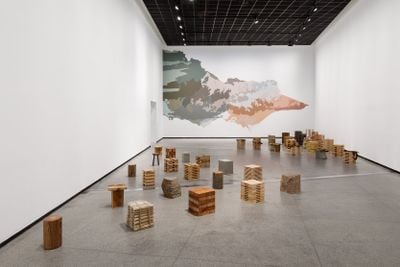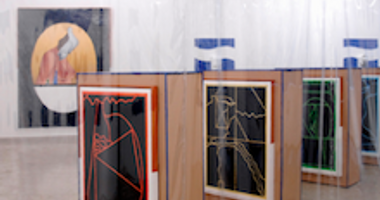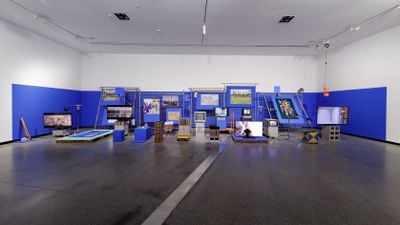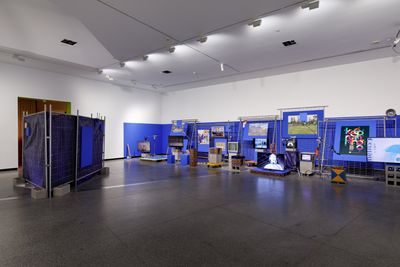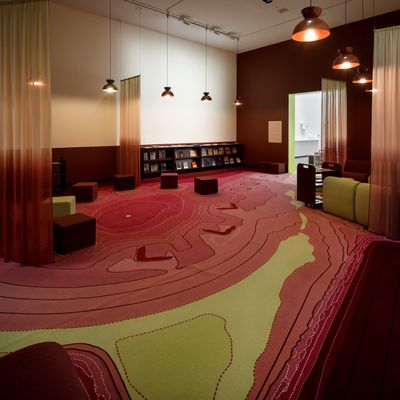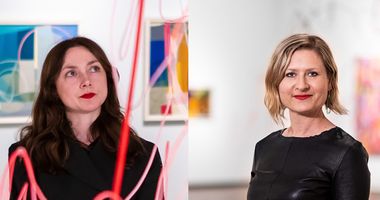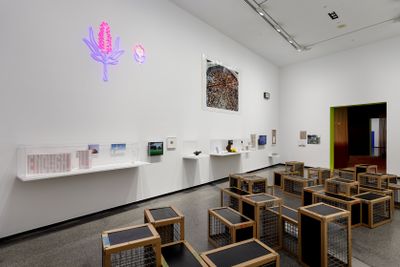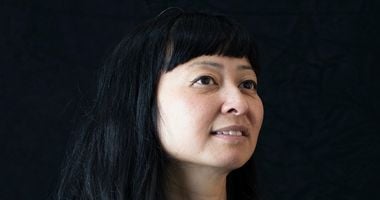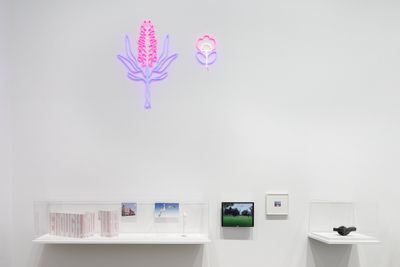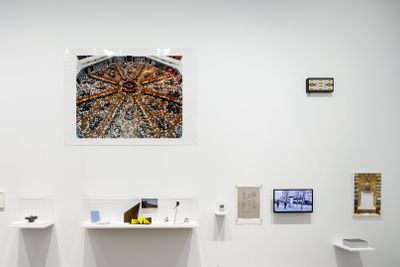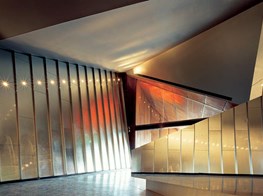Experimental, Collaborative, and Interdisciplinary: 'Who’s Afraid of Public Space?' at ACCA
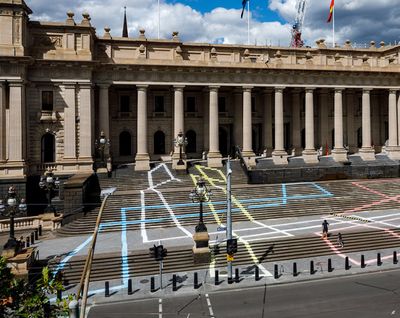
Who's Afraid of Public Space? Kerrie Poliness, Parliament Steps Walking Drawing (2021). Commissioned by the Australian Centre for Contemporary Art. Courtesy the artist and Anna Schwartz Gallery, Melbourne. Photo: Andrew Curtis.
Presented at the Australian Centre for Contemporary Art in Melbourne, Who's Afraid of Public Space? (4 December 2021–20 March 2022) poses pertinent questions about the viability of participatory public space today.
There are two conceptual layers to the exhibition. First is the question of what role the institution plays as a civic space that accounts for all bodies. Then there is the critique of public space in Melbourne, its accessibility, ownership, safety, and more.
To unpack these ideas, the exhibition is led by ACCA's core curatorial team—Max Delany, Annika Kristensen, and Miriam Kelly—in concert with an external curatorial advisory group, including professor Nikos Papastergiadis, artist and curator Nur Shkembi, and First Nations arts worker and artist Jarra Karalinar Steel, among others, each called upon for their specific areas of expertise.
Similar to the curatorial structure, the exhibition itself is experimental, collaborative, and interdisciplinary in nature. This is realised through the division of ACCA's exhibition galleries into four distinctive spaces: a reading lounge, a project space, a gathering platform, and an education workshop.
The first space that audiences encounter is Gathering Space: Ngargee Djeembana—a unique, first-time collaboration between esteemed Boon Wurrung senior elder N'arweet Carolyn Briggs AM and Palawa designer Sarah Lynn Rees.
Focused on public assembly, ceremony, dance, and performance, the intention, N'arweet Carolyn Briggs AM says, 'is focused upon bringing people together for cultural practice, ceremony and performance, giving us a place where we can create and find our own narratives.'
In making this the first stop of the exhibition, the curatorial team asserts that to understand public space in Australia, and other settler colonial contexts, audiences must first understand the First Nations knowledge, language, and culture that are essential to the place.
A constellation of 55 custom-made stools are arranged across the floor, each highlighting a different set of materialities indigenous to the Victorian region. These include native trees like myrtle beech and silver wattle, stones such as Mount Bolton granite, and materials including kangaroo leather.
Grounding Indigenous genealogies and placehood of materials, these functional objects—30 provide the means to seat audiences for discussions, community events, and performances—hold their own histories.
Although each stool is unique, with materials sourced from different places in Victoria, the palette of the installation is relatively regulated, informed by the eco-scape of the state. In the background, a topographical map of Victoria marks areas in the state where the stools' materials naturally occur.
The theme of sharing space with important cultural stakeholders, whether human or non-human, is continued in the second space titled Project Space: The Hoarding, designed by Melbourne-based architectural office Sibling Architecture.
This could be seen as the exhibition's engine room, providing a visual summary to the various offsite projects that have happened before, during, and will continue after the official exhibition period, which further test out ideas in context-specific scenarios like parliament steps, laneways, and parks.
Among the documentation is an excerpt of Destiny displayed on a monitor, a 2021 film exploring the platform economy by artist collective APHIDS—the full screening happened in a carpark in November 2021—and a documentary image of Never Alone, Kent Morris' digital billboard project instigated in August 2020 in St Kilda, Melbourne, showing the words 'never alone' against a geometric backdrop.
Visually uniting this grouping of projects is the ubiquitous blue hoarding material that lines the surrounding walls, accompanied by other temporary building materials such as trollies, Besser blocks, mesh fencing, and tarpaulin.
These materials are commonly used to control the flow of people in urban environments, and in temporary civic structures like pop-up medical clinics, festivals, and disaster relief centres: a nod to the temporary nature of an exhibition, and a fitting backdrop to unite snippets, previews, and documentation-based imagery of works presented offsite.
Similar to the curatorial structure, the exhibition itself is experimental, collaborative, and interdisciplinary in nature.
Next up is a reading room designed by emerging designers and editors Nicola Cortese, Lauren Crockett, and Stephanie Pahnis, titled Reading Space: The Common Room, which functions as a reading lounge, library, and study space.
Sourced from an open-call process, publications have been donated by members of the public to form a library of the commons. Titles include Spatial Practices: Modes of Action and Engagement with the City, edited by Melanie Dodd. This call-out was co-organised by an independent art, design, and architecture organisation known as Melbourne Art Library, to whom the publications will be donated following the exhibition's closure.
As with the first room, Reading Space: The Common Room has a functional capacity to house events in the Gathering space, while the reading space is more introverted in nature, with soft lighting and warm, earth-like contoured carpets.
Curtains, stools, and modular chairs can be moved around to comfortably situate an array of different social situations, such as solitary reading, one-on-one tutoring, a small reading group, or other smaller-scaled events and associated public programmes exploring themes of collections, distributions, library practices, and other reflective modes of thinking.
The fourth and final site is Education Space: Creating Art in Public, designed by artist-educator Andrew Atchison as a hybrid studio, classroom, and gallery with the aim to encourage active participation with public art practices.
Looking at the form of the propositional artwork as an accessible way to ideate problem-solving for the future, ACCA Education have formulated teaching activities that encourage students to create and view their own propositional public artworks.
Documentary images, cards, models, and other objects are installed in vitrines and mounted on walls, each referencing public artworks by contemporary artists, some of which are located in Melbourne, grounding the teaching activities in lived history.
References include an LED element drawn from Atong Atem's large-scale neon light sculptures of Australian flora in Melbourne's Southbank, Outdoor Living (2021), and a maquette of artist Ron Robertson-Swann's Vault (1980), a large yellow geometric structure outside ACCA that triggered waves of criticism from the media and general public when it was installed.
Overall, Who's Afraid of Public Space? is an ambitious staging of a wide constellation of sites, collaborators, public artworks, and performances that explore a broad spectrum of viewpoints addressing who and what constitutes public space, and how these spaces can and do function.
Interestingly, the show was created during the pandemic in a city that currently holds the record for longest cumulative days in lockdown, with fear and governance dramatically altering individual and collective approaches and relationships to common grounds.
Against that backdrop, the exhibition is an important reminder about the civic duties of art and cultural institutions, and the responsibility that everyone has in ensuring that public space continues to not only accommodate a wide range of publics, but accurately reflects the constituents of the city. —[O]

